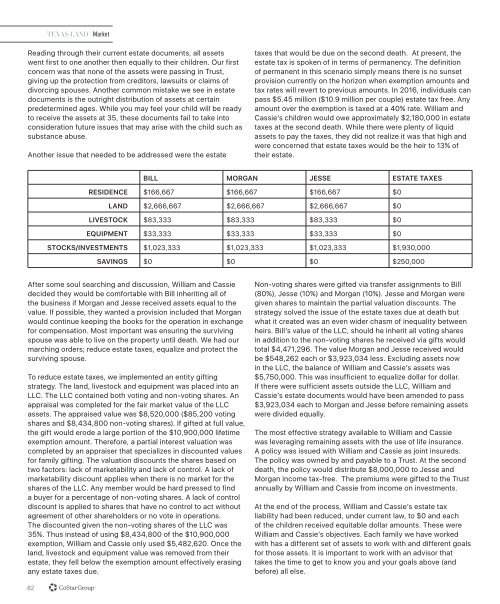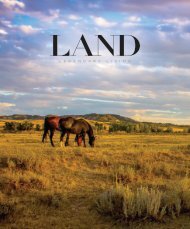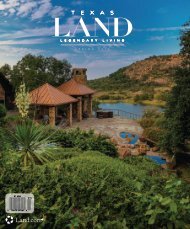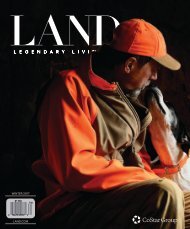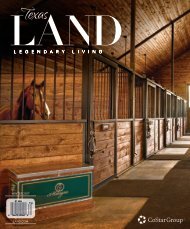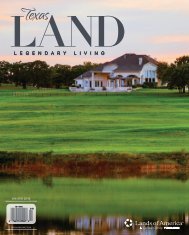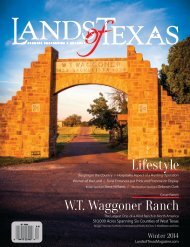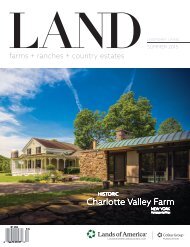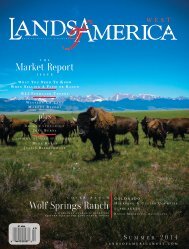You also want an ePaper? Increase the reach of your titles
YUMPU automatically turns print PDFs into web optimized ePapers that Google loves.
TEXAS LAND / Market<br />
Reading through their current estate documents, all assets<br />
went first to one another then equally to their children. Our first<br />
concern was that none of the assets were passing in Trust,<br />
giving up the protection from creditors, lawsuits or claims of<br />
divorcing spouses. Another common mistake we see in estate<br />
documents is the outright distribution of assets at certain<br />
predetermined ages. While you may feel your child will be ready<br />
to receive the assets at 35, these documents fail to take into<br />
consideration future issues that may arise with the child such as<br />
substance abuse.<br />
Another issue that needed to be addressed were the estate<br />
taxes that would be due on the second death. At present, the<br />
estate tax is spoken of in terms of permanency. The definition<br />
of permanent in this scenario simply means there is no sunset<br />
provision currently on the horizon when exemption amounts and<br />
tax rates will revert to previous amounts. In <strong>2016</strong>, individuals can<br />
pass $5.45 million ($10.9 million per couple) estate tax free. Any<br />
amount over the exemption is taxed at a 40% rate. William and<br />
Cassie’s children would owe approximately $2,180,000 in estate<br />
taxes at the second death. While there were plenty of liquid<br />
assets to pay the taxes, they did not realize it was that high and<br />
were concerned that estate taxes would be the heir to 13% of<br />
their estate.<br />
BILL MORGAN JESSE ESTATE TAXES<br />
RESIDENCE $166,667 $166,667 $166,667 $0<br />
LAND $2,666,667 $2,666,667 $2,666,667 $0<br />
LIVESTOCK $83,333 $83,333 $83,333 $0<br />
EQUIPMENT $33,333 $33,333 $33,333 $0<br />
STOCKS/INVESTMENTS $1,023,333 $1,023,333 $1,023,333 $1,930,000<br />
SAVINGS $0 $0 $0 $250,000<br />
After some soul searching and discussion, William and Cassie<br />
decided they would be comfortable with Bill inheriting all of<br />
the business if Morgan and Jesse received assets equal to the<br />
value. If possible, they wanted a provision included that Morgan<br />
would continue keeping the books for the operation in exchange<br />
for compensation. Most important was ensuring the surviving<br />
spouse was able to live on the property until death. We had our<br />
marching orders; reduce estate taxes, equalize and protect the<br />
surviving spouse.<br />
To reduce estate taxes, we implemented an entity gifting<br />
strategy. The land, livestock and equipment was placed into an<br />
LLC. The LLC contained both voting and non-voting shares. An<br />
appraisal was completed for the fair market value of the LLC<br />
assets. The appraised value was $8,520,000 ($85,200 voting<br />
shares and $8,434,800 non-voting shares). If gifted at full value,<br />
the gift would erode a large portion of the $10,900,000 lifetime<br />
exemption amount. Therefore, a partial interest valuation was<br />
completed by an appraiser that specializes in discounted values<br />
for family gifting. The valuation discounts the shares based on<br />
two factors: lack of marketability and lack of control. A lack of<br />
marketability discount applies when there is no market for the<br />
shares of the LLC. Any member would be hard pressed to find<br />
a buyer for a percentage of non-voting shares. A lack of control<br />
discount is applied to shares that have no control to act without<br />
agreement of other shareholders or no vote in operations.<br />
The discounted given the non-voting shares of the LLC was<br />
35%. Thus instead of using $8,434,800 of the $10,900,000<br />
exemption, William and Cassie only used $5,482,620. Once the<br />
land, livestock and equipment value was removed from their<br />
estate, they fell below the exemption amount effectively erasing<br />
any estate taxes due.<br />
Non-voting shares were gifted via transfer assignments to Bill<br />
(80%), Jesse (10%) and Morgan (10%). Jesse and Morgan were<br />
given shares to maintain the partial valuation discounts. The<br />
strategy solved the issue of the estate taxes due at death but<br />
what it created was an even wider chasm of inequality between<br />
heirs. Bill’s value of the LLC, should he inherit all voting shares<br />
in addition to the non-voting shares he received via gifts would<br />
total $4,471,296. The value Morgan and Jesse received would<br />
be $548,262 each or $3,923,034 less. Excluding assets now<br />
in the LLC, the balance of William and Cassie’s assets was<br />
$5,750,000. This was insufficient to equalize dollar for dollar.<br />
If there were sufficient assets outside the LLC, William and<br />
Cassie’s estate documents would have been amended to pass<br />
$3,923,034 each to Morgan and Jesse before remaining assets<br />
were divided equally.<br />
The most effective strategy available to William and Cassie<br />
was leveraging remaining assets with the use of life insurance.<br />
A policy was issued with William and Cassie as joint insureds.<br />
The policy was owned by and payable to a Trust. At the second<br />
death, the policy would distribute $8,000,000 to Jesse and<br />
Morgan income tax-free. The premiums were gifted to the Trust<br />
annually by William and Cassie from income on investments.<br />
At the end of the process, William and Cassie’s estate tax<br />
liability had been reduced, under current law, to $0 and each<br />
of the children received equitable dollar amounts. These were<br />
William and Cassie’s objectives. Each family we have worked<br />
with has a different set of assets to work with and different goals<br />
for those assets. It is important to work with an advisor that<br />
takes the time to get to know you and your goals above (and<br />
before) all else.<br />
82


